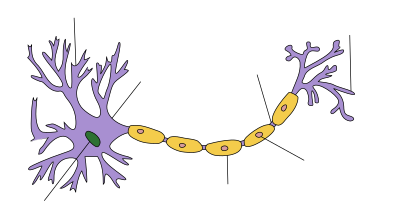Chronic inflammatory demyelinating polyneuropathy
| Chronic inflammatory demyelinating polyneuropathy | |
|---|---|
| Classification and external resources | |
| Specialty | Neurology |
| ICD-10 | G61.8 |
| ICD-9-CM | 357.81 |
| OMIM | 139393 |
| DiseasesDB | 30084 |
| eMedicine | neuro/467 |
| MeSH | D020277 |
| Neuron |
|---|
Chronic inflammatory demyelinating polyneuropathy (CIDP) is an acquired immune-mediated inflammatory disorder of the peripheral nervous system. The disorder is sometimes called chronic relapsing polyneuropathy (CRP) or chronic inflammatory demyelinating polyradiculoneuropathy (because it involves the nerve roots). CIDP is closely related to Guillain–Barré syndrome and it is considered the chronic counterpart of that acute disease. Its symptoms are also similar to progressive inflammatory neuropathy. An asymmetrical variant of CIDP is known as Lewis-Sumner Syndrome.
Chronic inflammatory demyelinating polyneuropathy, also known as Vidaurri's disease, is believed to be due to immune cells, which normally protect the body from foreign infection, incorrectly attacking the nerves in the body instead. As a result, the affected nerves fail to respond, or respond only weakly, and on occasion, inordinately, to stimuli, causing numbing, tingling, pain, progressive muscle weakness, loss of deep tendon reflexes (areflexia), fatigue, and abnormal sensations. The likelihood of progression of the disease is high.
CIDP is under-recognized and under-treated due to its heterogeneous presentation (both clinical and electrophysiological) and the limitations of clinical, serologic, and electrophysiologic diagnostic criteria. Despite these limitations, early diagnosis and treatment is important in preventing irreversible axonal loss and improving functional recovery.
Lack of awareness and treatment of CIDP is also due to limitations of clinical trials. Although there are stringent research criteria for selecting patients to clinical trials, there are no generally agreed-on clinical diagnostic criteria for CIDP due to its different presentations in symptoms and objective data. Application of the present research criteria to routine clinical practice often miss the diagnosis in a majority of patients, and patients are often left untreated despite progression of their disease.
Diagnosis is usually made through a clinical neurological examination. Patients usually present with a history of weakness, numbness, tingling, pain and difficulty in walking. They may additionally present with fainting spells while standing up or burning pain in extremities. Some patients may have sudden onset of back pain or neck pain radiating down the extremities, usually diagnosed as radicular pain. These symptoms are usually progressive and may be intermittent.
...
Wikipedia

